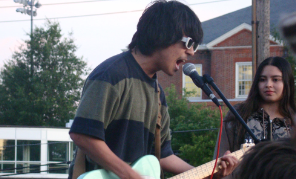Over the past few weeks, a video depicting Joseph Kony, the leader of the Lord’s Resistance Army (LRA), abducting children from northern Uganda has circulated around the Internet, most prominently on social networking sites such as Facebook. Kony was accused of exerting dangerous influence over the kids, by building up a militia of young boys and using the girls as sex slaves for the army.
According to the Invisible Children website, Kony’s goal, inherited from former leader Alice Lakwena, is to free northern Uganda from government rule. Lakwena started the movement in 1986, however, the actions of Kony and the LRA have come into the view of the general public only recently.
The organization Invisible Children tracks the actions of the LRA and works to aid the kids by establishing schools and other forms of education in Uganda. One of Invisible Children’s main goals is to inform the public of Kony and his actions, spread awareness around the globe and gain supporters for his capture and arrest. This goal has been made easier for the organization to meet with advancements in the media. The Kony 2012 campaign film, approximately 30 minutes long, was uploaded to YouTube by Invisible Children on March 5 and has since received over 83 million views.
Although the anti-Kony movement may seem like a one-of-a-kind Internet sensation, activism of this sort has actually grazed the worldwide web in the recent past.
In Jan. 2012, Americans opposed the passage of the Stop Online Piracy Act (SOPA) and the Protect IP Act (PIPA), which would place heavy regulations and censorship on the web in attempt to prevent Internet piracy. However, people argued that the passage of these acts would infringe on their right of free speech provided under the First Amendment. According to Google’s website, over seven million people signed an online petition to Congress.
“Your voice is being heard,” said a statement on the website. “Your elected representatives are beginning to recognize the damage these bills could inflict on the Web, and as a result, votes on PIPA and SOPA have been delayed.”
Now, as a result of the Kony video, people across the country have started campaigning to both aid the children in Uganda and persuade the government to take action against Joseph Kony, who is supposedly currently on the run.
According to the video, up until recently, the U.S. government refused to send military troops into the area, citing that Kony and his actions do not affect national security or the financial state of the country. But even with the U.S. supporting the cause, people have continued to work to spread the word about the movement. The video encourages viewers to put up as many posters up in their towns and cities on April 20, 2012, in order to cover the areas in a “blanket,” a symbol to others of the greatness and magnitude of the support in a country far away from the action.
And while the anti-Kony movement has tugged at the heartstrings of many, there are still others who are skeptical both about the organization and Kony himself. Some believe that Invisible Children’s information about Kony is inaccurate, and others are skeptical about the legitimacy of the organization. Others say that this issue is not a new one, and wonder why the movement has turned into a phenomenon just recently.
Perhaps most notably, according to an article from the New York Daily News, a screening of the video in Uganda yielded disappointment and anger. The Ugandan people had expected to see a film depicting their struggles since the raids, but instead were treated to a video featuring a white narrator and events of the past. The article also said that the people did not like the fact that ‘KONY 2012’ had been stamped onto merchandise; they interpreted it as a “celebration of their suffering.”
The end result of the anti-Kony movement remains to be seen, however, amid the criticism, the rapid spread of the video over the internet and the unification of Americans over an issue of humanity will leave a lasting stamp on civilization for years to come.








